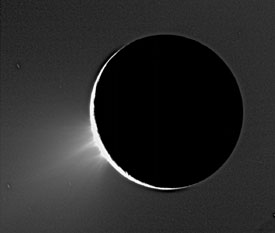
Finally astronomers have the photographic proof they've been looking for — ice volcanoes actively erupting on Enceladus. In January the Cassini spacecraft looked back toward Saturn's icy moon and caught its profile backlit by sunlight. In those images, several discrete plumes tower above the 500-kilometer-wide satellite. The spray fills Saturn's E ring with icy particles that ultimately coat many of the planet's other satellites.
Courtesy NASA/JPL/Space Science Institute.
Finally astronomers have the photographic proof they've been looking for: ice volcanoes actively erupting on Enceladus. On November 27th the Cassini spacecraft looked back toward Saturn's icy moon and caught its profile backlit by sunlight. In those images, several discrete plumes tower above the 500-kilometer-wide satellite. The spray populates Saturn's E ring with water-ice particles that ultimately coat many of the planet's other satellites.
As expected from other Cassini observations, the eruptions stem from the moon's "tiger stripe" region, a zone in the southern hemisphere that is significantly warmer and geologically fresher than the icescapes to the north. Enceladus also sports a tenuous atmosphere over its southern half.
 0
0
Comments
You must be logged in to post a comment.